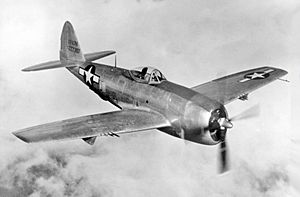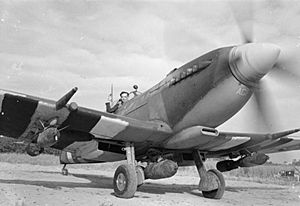Fighter-bomber facts for kids

A fighter-bomber is a type of fighter aircraft that is also used to drop bombs or attack targets on the ground. Think of it as a fast, agile plane that can both fight other planes and carry bombs. It's different from a regular bomber because it started out as a fighter plane, then was changed to do bombing missions too.
Today, planes that do similar jobs are often called multirole combat aircraft or strike fighters. This is because they can do many different tasks, not just fight or bomb.
How Fighter-Bombers Developed

Before World War II, planes were usually built for one specific job. For example, a bomber was just for bombing, and a fighter was just for fighting other planes. This was because engines weren't very powerful back then.
But during World War II, airplane engines got much stronger. Between 1939 and 1943, engine power almost doubled! This meant that smaller, faster fighter planes could now carry heavy bombs.
For example, the Bristol Blenheim was an early bomber. It had two engines and could carry about 1,200 pounds (544 kg) of bombs. But it was slow and easily shot down by enemy fighters.
Then came planes like the Vought F4U Corsair and the Republic P-47 Thunderbolt. These were powerful single-seat fighter planes with very strong engines. The Corsair, for instance, could carry 2,000 pounds (907 kg) of bombs, and later versions could carry even more! The P-47 Thunderbolt, shown in the picture, was also very strong and could carry a lot of weapons.
Because of these stronger engines, many existing fighter planes were changed to become fighter-bombers. Famous examples include the Focke-Wulf Fw 190, the Hawker Typhoon, and the Republic P-47 Thunderbolt. These planes could drop bombs from high up, or fly low to attack targets on the ground. Some were even designed to dive steeply towards their targets to drop bombs accurately.
Larger planes with two engines also became fighter-bombers, especially for long-distance missions or attacks on ships. The Lockheed P-38 Lightning and the de Havilland Mosquito are good examples of these.
Fighter-Bombers After the War
After World War II, jet engines made planes even faster and more powerful. This made fighter-bombers even more important. Many planes that were first designed just to fight other aircraft later became fighter-bombers.
A good example is the Lockheed F-104 Starfighter. It was first built as a very fast fighter plane. But it was later used in Europe to carry special bombs for ground attacks. Another well-known fighter-bomber was the McDonnell Douglas F-4 Phantom II, which was used a lot during the Vietnam War. These planes showed how versatile fighter-bombers had become.
Images for kids
-
The F-series models of the Focke-Wulf Fw 190 were specifically adapted for the fighter-bomber role.
-
A Vought F4U Corsair with USMC markings
See also
 In Spanish: Cazabombardero para niños
In Spanish: Cazabombardero para niños
- Dive bomber
- Light bomber
- Tactical bombing
- Attack aircraft
- Multirole combat aircraft
- Strike fighter






